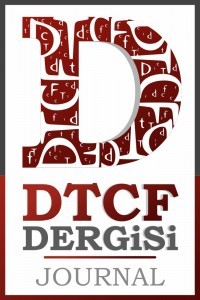OSMANLI DÖNEMİ'NDE KULLANILAN İKİ ANALOG BİLGİSAYAR: RUBÛ' EL-MÜCEYYEB VE PERGÂR-I NİSBE
Matematik Tarihi, Teknoloji Tarihi, Osmanlı Teknolojisi, Osmanlı Matematiği, Sektör, Pergar-ı Nisbe, Trigonometrik (Sinüs) Kadran, Rubû
TWO ANALOGUE COMPUTERS IN THE OTTOMAN ERA: TRIGONOMETRIC SINE QUADRANT AND SECTOR
History of Mathematics, History of Technology, Ottoman Technology, Ottoman Mathematics, Sector, Proportional Compass, Trigonometric (Sine) Quadrant, Quadrant,
___
- Acar, M. Şinasi, Atilla Bir ve Mustafa Kaçar. Rubu Tahtası Yapım Klavuzu (Rubu Dâirenin Esâsı ve Usûl-i Tersimi). İstanbul: Ofset, 2014.
- Beydilli, Kemal. Türk Bilim ve Matbaacılık Tarihinde Mühendishane ve Mühendishane Matbaası ve Kütüphanesi (1776-1826). İstanbul: Eren, 1995.
- Demir, Remzi. “Eski Bir Hesap Aleti: Rub’u’l-Müceyyeb ve Takiyüddin ibn Maruf’un Rub’u’l-Müceyyeble Yapılan İşlemler Manzumesi Adlı Risalesi.” Bilim ve Felsefe Metinleri 1.1 (1992): 29-52.
- Dizer, Muammer. Rubu Tahtası. İstanbul: Boğaziçi Üniversitesi, 1987.
- Gökmen, Fatin. Rubu Tahtası, Nazariyatı ve Tersimi. İstanbul: Milli Eğitim Basımevi, 1948.
- Istituto e Museo di Storia della Scienza Museo Galileo Catalogue Florence-ITALY:
- 2015. Web. 22 Aralık 2016.
- Istituto e Museo di Storia della Scienza Museo Galileo. Galileo’s Compass. Florence: 2004. Web. 22 Aralık 2016.
- İshak Efendi. Mecmu‘a-yı ‘Ulûm-ı Riyâzıye. İstanbul: Matbaa-i Amire. 1831.
- King, David. Islamic Astronomical Instruments. London: Variorum Reprints,1987.
- Leupold, Jacob. Theatrum Arithmetico-Geometricum. Leipzig: Bernhard Christoph Breitkopf und Sohn, 1727.
- Polat, Atilla. “Treatises on Pergâr-ı nisbe (Sector) in the manuscript collections of Turkey.” XXVth Scientific Instrument Symposium: Instruments between East and West. İstanbul. 29.09.2016.
- Stone, Edmund. The Construction and Principal uses of Mathemathical Instruments; Translated from the French of M. Bion Chief Instrument-Maker to the French King. Londra: H. W for J. Senex and W. Taylor, 1723.
- “Technology.” Cambridge University Online Dictionary. Cambridge Advanced Learner’s Dictionary & Thesaurus Online, 2017. Web. 2 Ocak 2017.
- Tomash Erwin ve Williams Michael R. “The Sector: It’s History, Scales and Uses.” EEE Annals of the History of Computing 25. 1 (2003): 34-47.
- Turner, Gerard L’E. Scientific Instruments 1500-1900. California: University of California,1998.
- Unat, Yavuz. İlk Çağlardan Günümüze Astronomi Tarihi. Ankara: Nobel, 2013.
- Zack M. ve Landry E. Research in History and Philosopy of Mathematics (The CSHPM 2014 Annual Meeting in St. Catharines, Ontario). Basel: Birkhaeuser, 2015.
- Ziya, Ahmed. Rubu Dâirenin Sûret-i İsti’mâli. İstanbul: Kandilli Boğaziçi, 1919-20 (Hicri 1338).
- Yayın Aralığı: Yılda 2 Sayı
- Başlangıç: 1942
- Yayıncı: Ankara Üniversitesi
GEOFFREY CHAUCER'IN TROLIUS VE CRISEYDE ESERİNDE KÜLTÜRÖTESİLİK
MONARŞİ VE MODERNİTE: ÇEK MİLLİYETÇİLİĞİ VE HABSBURG İMPARATORLUĞU'NUN SON DÖNEMİ
Semanur ÖZTEMİZ, Bülent YILMAZ
ULUSAL STRATEJİLER ÇERÇEVESİNDE BİRLİKTE ÇALIŞABİLİRLİK EYLEMLERİNİN DEĞERLENDİRİLMESİ
Saime Özlem GÖKKURT, Hakan DEMİRTEL
THE WEARY GENERATIONS ROMANINDA POLİTİK VE TARİHİ OLGULAR
İLKOKUL, ORTAOKUL VE LİSE ÖĞRENCİLERİNDE ULAMSAL ÖRGÜTLEME ÇERÇEVESİNDE TAKSONOMİK FARKINDALIK
ANNEMİN OTOBİYOGRAFİSİ: POST/KOLONYAL TRAVMAYA ULAŞMA YOLU OLARAK ANLATI
GIOVANNI PAPINI'NİN BİTİK ADAM ADLI YAPITINDA PRAGMATİZME BAKIŞ
OSMANLI DÖNEMİ'NDE KULLANILAN İKİ ANALOG BİLGİSAYAR: RUBÛ' EL-MÜCEYYEB VE PERGÂR-I NİSBE
